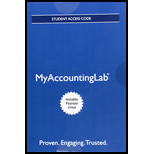
Concept explainers
(1)
Accounts receivable refers to the amounts to be received within a short period from customers upon the sale of goods and services on account. In other words, accounts receivable are amounts customers owe to the business. Accounts receivable is an asset of a business.
Bad debt expense is an expense account. The amounts of loss incurred from extending credit to the customers are recorded as bad debt expense. In other words, the estimated uncollectible accounts receivable are known as bad debt expense.
Direct write-off method:
This method does not make allowance or estimation for uncollectible accounts, instead this method directly write-off the actual uncollectible accounts by debiting bad debt expense and by crediting accounts receivable. Under this method, accounts would be written off only when the receivables from a customer remain uncollectible.
To journalize: The write-off of $1,100 of accounts receivable as uncollectible, under direct write-off method.
(2)
Person V’s balance in accounts receivable at May 31, 2018.
Want to see the full answer?
Check out a sample textbook solution
Chapter 8 Solutions
MyLab Accounting with Pearson eText -- Access Card -- for Horngren's Financial & Managerial Accounting, The Managerial Chapters
- The following are selected account balances from Penske Company and Stanza Corporation as of December 31, 2024: Accounts Revenues Cost of goods sold Depreciation expense Investment income Dividends declared Retained earnings, 1/1/24 Current assets Copyrights Royalty agreements Penske $ (700,000) 250,000 150,000 Not given 80,000 (600,000) 400,000 Investment in Stanza Liabilities Common stock Additional paid-in capital Stanza $ (400,000) 100,000 200,000 Ө 60,000 (200,000) 500,000 400,000 900,000 600,000 1,000,000 Not given (500,000) Ө (1,380,000) (600,000) ($20 par) (150,000) (200,000) ($10 par) (80,000) Note: Parentheses indicate a credit balance. On January 1, 2024, Penske acquired all of Stanza's outstanding stock for $680,000 fair value in cash and common stock. Penske also paid $10,000 in stock issuance costs. At the date of acquisition, copyrights (with a six-year remaining life) have a $440,000 book value but a fair value of $560,000. Required: a. As of December 31, 2024, what is…arrow_forwardMCQarrow_forwardhelp me to solve this questionsarrow_forward
- Accurate answerarrow_forwardGive this question general accounting answerarrow_forwardThe Rolling Department of Kama Steel Company had 2,000 tons in beginning work in process inventory (80% complete) on October 1. During October, 30,660 tons were completed. The ending work in process inventory on October 31 was 1,928 tons (80% complete). What are the total equivalent units for direct materials for October if materials are added at the beginning of the process?arrow_forward

 AccountingAccountingISBN:9781337272094Author:WARREN, Carl S., Reeve, James M., Duchac, Jonathan E.Publisher:Cengage Learning,
AccountingAccountingISBN:9781337272094Author:WARREN, Carl S., Reeve, James M., Duchac, Jonathan E.Publisher:Cengage Learning, Accounting Information SystemsAccountingISBN:9781337619202Author:Hall, James A.Publisher:Cengage Learning,
Accounting Information SystemsAccountingISBN:9781337619202Author:Hall, James A.Publisher:Cengage Learning, Horngren's Cost Accounting: A Managerial Emphasis...AccountingISBN:9780134475585Author:Srikant M. Datar, Madhav V. RajanPublisher:PEARSON
Horngren's Cost Accounting: A Managerial Emphasis...AccountingISBN:9780134475585Author:Srikant M. Datar, Madhav V. RajanPublisher:PEARSON Intermediate AccountingAccountingISBN:9781259722660Author:J. David Spiceland, Mark W. Nelson, Wayne M ThomasPublisher:McGraw-Hill Education
Intermediate AccountingAccountingISBN:9781259722660Author:J. David Spiceland, Mark W. Nelson, Wayne M ThomasPublisher:McGraw-Hill Education Financial and Managerial AccountingAccountingISBN:9781259726705Author:John J Wild, Ken W. Shaw, Barbara Chiappetta Fundamental Accounting PrinciplesPublisher:McGraw-Hill Education
Financial and Managerial AccountingAccountingISBN:9781259726705Author:John J Wild, Ken W. Shaw, Barbara Chiappetta Fundamental Accounting PrinciplesPublisher:McGraw-Hill Education





